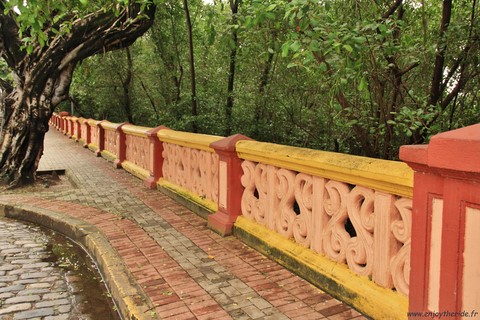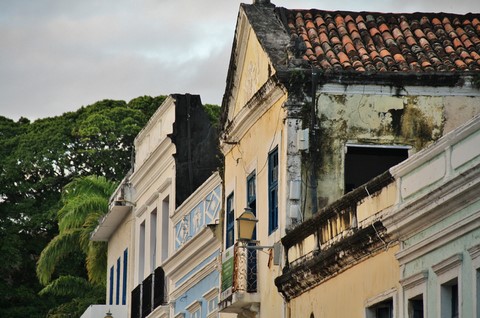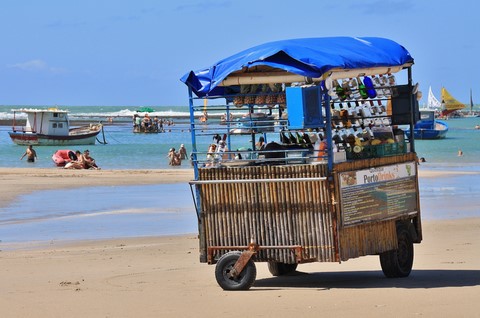State of Pernambuco
You can click on pictures to enlarge them
Recife
Recife is one of the oldest cities in Brazil (17th century). Strategic port for trade, then later for industry, its center is enclosed in a network of rivers which makes it typical, but which causes difficulties in finding one's bearings.
Honestly, it is the city we loved the least during that trip. We found too few attractive places. Those last mentioned are concentrated in the Historic Center – very clean unlike some other districts – and which beautiful architecture reminded us in some places Northern Europe, Central Europe and Eastern Europe. Moreover, we ran into problems in Recife, which are related in the «Our anecdotes - Brazil» section.
Naturally, it is in the Recife Antigo (Old Recife) that stands the geographic center of the state, more specifically on the Bairro de Recife islet: Praça Rio Branco is precisely known as «Marco Zero» (kilometer zero). It is in some kind of way the equivalent of the Praça Da Sé in São Paulo. Nevertheless, it is more pleasant, more airy and less sleazy. The view of the port and the ocean is beautiful. The Zero Marker is surrounded by a compass rose masterfully crafted by a local painter: Cicero Dias. Nice buildings rise in the surroundings: the Malakoff Tower in Tunisian style houses an astronomical observatory. The Church Madre de Deus and the Theatre Apolo are as much remarkable. The Forte do Brum, fort of the 17th century, contains the Military Museum. The Rua do Bom Jesus enjoys two main attractions: the Kahal Zur Israel Synagogue, and the Embaixada dos Bonecos Gigantes which houses giant dolls dedicated to parades during the beautiful carnivals in Recife and Olinda, nearby. Those last mentioned are as much famous in the country as the ones in Rio de Janeiro and Salvador de Bahía, much less abroad. Many people even agree that they are more authentic, less touristy. Some of those dolls represent celebrities, as much from the political world as from the world of show-business.
The historic bridge Mauricio de Nassau leads to Santo Antônio district (photo), mainly known for the superb Praça da República, which gardens planted with palm trees and adorned with sculpture tempt to a relaxed rhythm of life. A baobab and a fountain complete the picture. Nearby rise the Palácio do Campo das Princesas, the Palácio da Justiça, the Teatro Santa Isabel and the Dourada Chapel. Not very far stands a trading and crafts complex where shops and art galleries abound. The reason for its construction in the shape of a cross is that it was formerly a prison, and it allowed prison guards to keep an eye on every cell. Nearby, the former Train Station of Recife, from the 19th century, was turned into a Train Museum. It is also the last stop of the subway line. It is one of the most beautiful historic buildings in town.
In the center - off-putting except the places mentioned above – the large Mercado de São José designed and built by French architects, offers a multitude of little shops that propose very varied products from handcraft to foodstuffs. The place is very popular, so you will have no difficulty in mingling with the crowd essentially composed of locals. However, it is inadvisable to linger there when those shops are closed.
We stayed in a hotel near Boa Viagem beach, a few minutes bus ride away from the city center, which is generally advised. Indeed the place is safer, and it is the only attractive beach in Recife, even though it has not escaped intensive concreting. Seven kilometers long, the water temperature there is nice. Nevertheless, do not swim too far from the sand because sharks make their way offshore and can sometimes get closer. In that district, we ate at Ponteio, a first-choice churrascaria. Meats were varied and delicious, and the buffet that went with them was high quality; our best restaurant during that trip.
Olinda
Third oldest town in Brazil, it was the first Pernambuco capital before handing it to Recife, nearby. It was founded in the 16th century, but its beautiful Historic Center only dates back to the 17th century, after it was burned by the Dutch and rebuilt. Perched on a hill planted with coconut trees, it is full of Baroque churches, and its splendid and very colored center reminds inevitably Pelhourino district in Salvador de Bahía. Besides, it is classified UNESCO world heritage site. However, it is a little less picturesque, and above all less lively. But what makes the beauty of Olinda is precisely its peace tinged with nostalgia, hardly disturbed every now and then by the night time show of a capoeira known as one of the best in the country. Obviously, that deeply rooted tranquility gives way once a year to the fervor of a spectacular and quite beautiful carnival. It is known as the most authentic and the most creative in Brazil. Even preparations and rehearsals alone constitute performances.
Most of walls of churches and convents have undergone the wear of time, but it gives them an added charm and an undeniable authenticity. It’s the same for abandoned tropical gardens, which have been reclaimed by nature. The Church and the Monastery of São Bento are a beautiful architectural ensemble from the 16th century located at the end of a dead end street. It was burned by the Dutch and finally rebuilt in the 18th century. The Baroque altar and its wooden pieces are superb. The Church Nossa Senhora do Carmo was the first building of the Carmelite Order in America. It was built in 1580 on Praça do Carmo, square filled with greenery and pleasantly planted with trees. It is lightly elevated and its surroundings offer a nice view of the ocean.
On the Alto da Sé stands the Church São Salvador Do Mundo, with very simple symmetric façade and interior decoration. Its two main attractions are azulejos remains and furniture made of jacaranda in the sacristy. On that square stands also the Religious Art Museum and the Palace of Yemanja, the Goddess of Water to whom a true act of worship is made. A little market offers clothes and lace. To admire the town, a panoramic elevator rises nearby: the Elevador Panorâmico do Alto da Sé. It was built next to a particularly ugly and massive 20 meters high building: the Caixa D’Agua de Olinda. But it offers a stunning view of the ocean, only marred by blocks of skyscrapers in Recife.
You may sometimes find artists’ studios, for the town has an important artistic tradition. Besides, you will see murals on some individual houses often made by owners themselves. The Mercado Da Ribeira, from the 17th century offers handicrafts, as well as wood sculptures, paintings or other artworks.
We ate at the Beijupirá, restaurant nested in side of hill. It has a room and a terrace. To get there, you use a funicular. The descent in the heart of a wooded park is picturesque. The place is charming and typical, and the shaded area allows you to tune out completely whereas it is right in the middle of the Historic Center. The view of Olinda is beautiful.
Porto de Galinhas
South of Recife, that sumptuous seaside resort is a real place of paradise: coral reefs, lagoons, turquoise water with changing colors according to the tide. Besides, when it’s low, natural pools are formed. It’s the ideal opportunity to admire closely coral, and to provide yourself with a diving mask and a snorkel to swoon over shoals of fish among which you will swim carelessly… before the return of waves with high tide.
You may meet local troubadours who will come to you to sing you songs composed spontaneously according to the inspiration of the moment. Obviously, they will wait for a gesture from you. Generally, you will be much (too much?) solicited by tourism professionals who will provide you various services: boat rides, buggy rides… Others will approach you to persuade you to lie on the deckchairs in front of their barraca and eat there, praising the quality of their food products, which will turn out to be poor frozen food hastily cooked.
Indeed, here is the other side of the coin: the touristic overexploitation of that idyllic place inevitably much appreciated. But if you make an effort to walk long enough to get far from that sometimes overwhelming bustle, you will almost recover wild nature, and return to that impression of earthly paradise that caught you as soon as you arrived.
Published on April, 27th 2016






